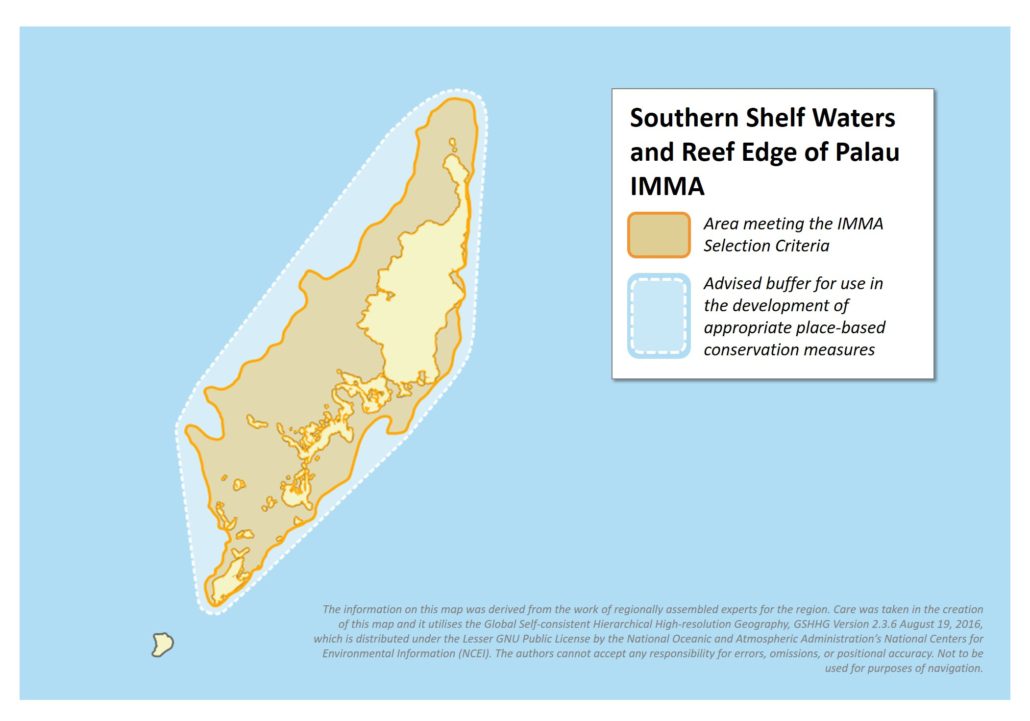Size in Square Kilometres
1,490
Qualifying Species and Criteria
Dugong – Dugong dugon
Criterion A; B (1, 2); C (1, 2); D (1)
Criterion D (2) – Marine Mammal Diversity
Other Marine Mammal Species Documented
Feresa attenuata, Globicephala macrorhynchus, Peponocephala electra, Physeter macrocephalus, Pseudorca crassidens, Stenella attenuata, Stenella longirostris
Summary
The Palau IMMA hosts a small resident dugong (Dugong dugon) population that is considered one of the world’s most isolated dugong populations. It is separated by at least 800 km from all other known populations. It is estimated at between 50-200 individuals that typically occur in groups of 3 or less, but occasionally in larger aggregations.
Description of Qualifying Criteria
Criterion A – Species or Population Vulnerability
Dugongs (Dugong dugon) are listed as a vulnerable on the IUCN Red List. However, a regional assessment of dugong by Marsh et al. (2011) concluded the Palau population as Critically Endangered and very isolated. The closest dugongs are 800 km to the south in Papua Barat and 850 km to the west in the Philippines (Marsh et al. 2002).
Criterion B – Distribution and Abundance
Sub-criterion B1 – Small and Resident Populations
An aerial survey conducted in 2012, covered a total area of 292 km2, which is only 4% of the total potential dugong habitat in Palau. During 192 flights over the course of 140 days, 912 dugong sightings were recorded. One to three dugongs were seen on most flights (Davis, 2004). The abundance estimate was 50-200 individuals (Davis, 2004).
Sub-criterion B2 – Aggregations
Most sightings during aerial surveys included 1-3 individuals, there have been at least two recorded sightings of aggregations of 30 individuals or larger around the waters of Palau (Etpison, 2012).
Criterion C: Key Life Cycle Activities
Sub-criterion C1 – Reproductive Areas
During aerial surveys in 2012, during which 912 dugong sightings were made, 53 calves accompanied by their mothers were recorded (on 6% of total flights) (Davis, 2004). Therefore, the waters of Palau are used by the resident dugong population for reproduction
Sub-criterion C2: Feeding Areas
Dugong in Palau are resident and are observed feeding largely in seagrass beds (Davis, 2004, Etpison, 2012, Holm, 2017 Pers. Comm.).
Sub-criterion C3: Migration Routes
C3a – Whale Seasonal Migratory Route
C3b – Migration / Movement Area
Criterion D – Special Attributes
Sub-criterion D1 – Distinctiveness
The Palau dugong population is considered one of the world’s most isolated dugong populations, separated by at least 800km from all other known populations (Etpison, 2012, IUCN 2015).
Sub-criterion D2 – Diversity
Supporting Information
Davis, P. Z. 2004. Current status of knowledge of dugongs in Palau: A review and project summary report. Koror: The Nature Conservancy.
Etpison, M. 2012. Palau Dugong dugon awareness campaign: 2010-2011. Koror: Coral Reef Research Foundation.
Marsh, H.P. 2002. The dugong (Dugong dugon) status reports and action plans for countries and territories in its range. Early Warning and Assessment Reports. Nairobi: United Nations Environment Programme.
Marsh, H.P. 2011. The ecology and conservation of Sirenia: dugongs and manatees. Cambridge: Cambridge University Press.
Palau National Government. 2001. Increased penalties for illegal taking, possessing or exporting dugongs and turtles. Palau National Government Report (2001, October). RPPL 6-28. Republic of Palau.
Downloads
Download the full account of the Southern Shelf Waters and Slope Edge of Palau using the Brochure button below:
To make a request to download the GIS Layer (shapefile and/or geojson) for the Southern Shelf Waters and Slope Edge of Palau please complete the following Contact Form:



